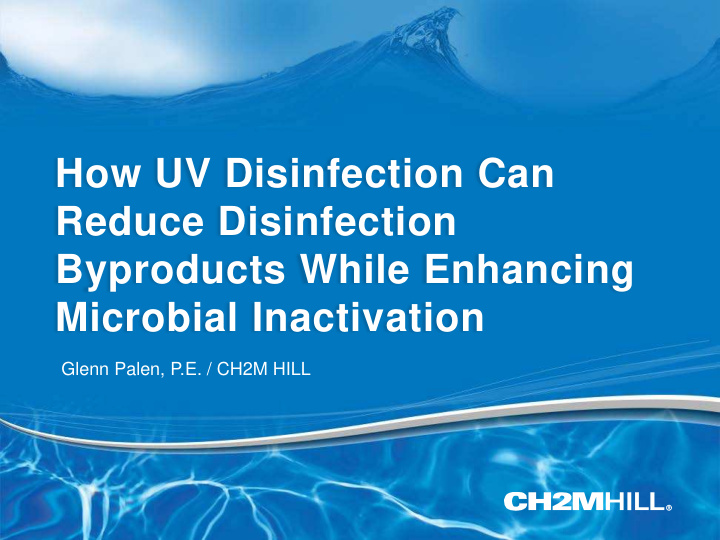



How UV Disinfection Can Reduce Disinfection Byproducts While Enhancing Microbial Inactivation Glenn Palen, P.E. / CH2M HILL
Project Background - Current Plant Configuration
City of Norfolk VA Department of Utilities Raw Water Source ─ Reservoir System consisting of three lakes in Suffolk and additional lakes in Norfolk and Virginia Beach ─ Fed from Various Sources • Runoff to Drainage Area • Lake Gaston • Blackwater River • Nottoway River ─ Average TOC in Raw Water = 3-7 mg/l
City of Norfolk VA Department of Utilities City Operates Two Water Treatment Plants 37 th Street (28 mgd) Moores Bridges (108 mgd)
37 th Street WTP Plant Originally Constructed in 1920 Expanded in 1940, with Numerous Subsequent Upgrades
37 th Street WTP Backwash Intermediate Equalization Pump Station Basin Filter Bldg Chemical/ Operations Bldg Residuals PS 4.0 MG FW Storage Floc/Sed Tank (above) Clearwells High (below) Pressure PS
37 th Street WTP Treatment Process: Ammonia Chlorine Disinfection Rapid Floc/ Pump/ FW Filters In Storage Mix Sed Storage Pumps Clearwells Enhanced Coagulation with Ferric Sulfate at Depressed pH Chlorinate Upstream of Filters for Mn Control DBP Control Strategy: Enhanced Coagulation + Chloramines in Distribution System
37 th Street WTP Clearwells are Located Beneath Floc/Sed Basins (Double Deck Arrangement) Limited Baffling in Existing Clearwell Settled Water to Filters Disinfected Filtered Raw Raw Water Water Water Water Clearwell/Disinfection Floc/Sed (Lower Level) (Upper Level)
37 th Street WTP Potential for Contamination from Sed Basins Above Favors Chlorinating the Entire Clearwell Large Clearwell Volume results in a High Degree of Log Inactivation with Free Chlorine Sed Basins Sed Basins Clearwells Clearwells
37 th Street WTP Phase III Upgrade – Disinfection Design
37 th Street WTP Site Layout New UV Disinfection IPS Exist. 4.0 Exst. MG Backwash New FW Storage Equalization Filters Basin Exst. Chemical/ Operations Bldg Exist. Filter Bldg Floc/Sed (above) Settled Water CCB (below) Exist. High Service PS Exist. Residuals PS New Settled Water PS
Initial Phase III Upgrade Design Approach Add Serpentine Baffles to existing clearwells and operate as parallel Settled Water Chlorine Contact Basins (CCB) Replace existing 1920/1940 vintage filters with new Deep Bed Filters CCBs limit settled water contamination risk from above Chlorine Ammonia New Low Rapid Floc/ New FW CCB SW Lift Storage Mix Sed Filters Pumps Pumps Pumps
Initial Design Approach Disinfection Contact Time Effectively Increased with Improved Baffling (less short circuiting) Current Clearwell Baffling Proposed CCB Baffling
Summer 2012 First Application of New Stage II DBP Distribution System Sampling Points Tropical Storm Irene Flushed Natural Organic Material into Reservoirs in fall of 2011 and Stirred Things Up ─ Raw Water TOC Levels and Finished Water DBP’s Increased in 2012 ─ Enhanced Coagulation Treated the Water and Regulatory Compliance Maintained but DBP Levels were Higher City Reviewed Finished Water DBP Goals and Lowered their THM Target This Series of Events Revealed the Vulnerability of Proposed Phase III Disinfection Approach
Treatment Approach Reviewed to Achieve Revised DBP Goals Further Enhancement of Coagulation Process seemed Impractical Considered Shifting Point of Chlorine Addition Further Downstream in Clearwells ─ Risk of Contamination from Sed Basins Above Still Present ─ Existing Disinfection Benchmark Difficult to Meet Considered Lowering Operating Level in Clearwell to Reduce Chlorine Contact Time ─ Reduction in Settled Water Storage Volume Created New Risks to Plant Operations /Reduced Operational Flexibility ─ Additional Chloraminated Finished Water Storage Could be Added to Maintain Flexibility at a Higher Project Cost
DBP Formation Rates Reviewed to Confirm Optimum Free Chlorine Contact Time Significant reductions in free chlorine contact time are required to achieve city’s finished water DBP goals ─ Contact Times <30 minutes are preferred for optimal DBP control ─ 10-12 minute Contact Time required for 0.5-log Giardia inactivation @ 3.0 mg/L free chlorine concentration ─ 2-log Virus inactivation also required, but Giardia c riteria governed Conclusion: Based on DBP formation rates; the disinfection benchmark requirements and the city’s DBP goals are difficult to achieve without adding a new disinfection process that does not produce chlorinated DBP’s
New Multiple Barrier Disinfection Approach Selected to Meet DBP and Disinfection Goals Chlorine fed upstream of filters to maintain Mn control strategy Free chlorine Contact Time limited to 10-12 minutes at design flows (0.5-log Giardia inactivation) ─ Achievable through deep bed filters and downstream PS wet well UV sized to provide a minimum of 1-log giardia inactivation with one reactor out of service ─ Conservative design dose = 40 mJ/cm 2 Ammonia added immediately downstream of UV Chlorine Ammonia SW New Low Rapid Floc/ New FW Storage SW Lift UV Storage Mix Sed Filters Pumps Basin Pumps Pumps
New Multiple Barrier Disinfection Approach Selected to Meet DBP and Disinfection Goals Advantages ─ Safeguards drinking water against most microorganisms treated by chlorine ─ Inactivation of chlorine-resistant protozoa, including Cryptosporidium and Giardia. Trojan
New Multiple Barrier Disinfection Approach Selected to Meet DBP and Disinfection Goals Advantages: ─ Disinfection process enhanced by adding a second disinfection barrier ─ Design free-chlorine Contact Time achieves 0.5-log Giardia inactivation ─ City’s DBP goals are achieved ─ Current Settled and Finished Storage Volumes Maintained
New UV Disinfection Building Constructed on Existing Backwash Equalization Basin UV Reactor New UV Building UV Reactor Existing South Backwash Equalization Basin (Below) Plan View
New UV Disinfection Building Constructed on Existing Backwash Equalization Basin UV Reactor Building - Section View Feed and Discharge Piping Installed Overhead to Reduce Footprint to Match Existing Basin Flow Meter and Control Valve Provided on Each Discharge Pipe UV Reactor UV Reactor
UV Disinfection Reactors Designed Around Trojan and Calgon Equipment Long Term Manufacturer’s of UV Disinfection Equipment Medium Pressure UV Design Reactors Validated in Accordance with EPA UVDGM Maximum Flow per Reactor = 17 mgd Reactor Size: 24-inch
Conclusions UV Disinfection Can Provide a Relatively Low Cost Option to Reduce Finished Water DBP’s and Enhance Disinfection in Plants that Already Practice Enhanced Coagulation and Chloramine Secondary Disinfection UV Disinfection Coupled with Free Chlorine Disinfection Can be Combined to Meet Disinfection Benchmark Requirements
Questions?
Recommend
More recommend